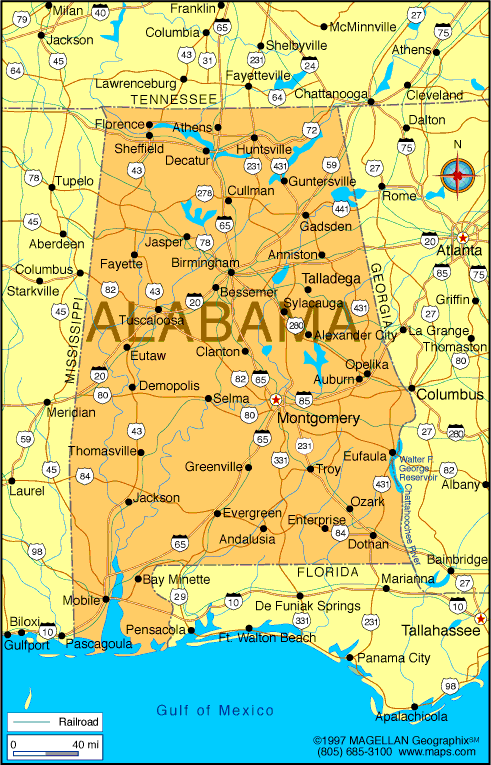Alabama

Alabama State Facts
Organized as territory: March 3, 1817
Entered Union: Dec. 14, 1819 (22nd State)
Present constitution adopted: 1901
Fun Facts
State abbreviation/Postal code: Ala./AL
Nickname: Yellowhammer State, also unofficially the Heart of Dixie
Origin of name: From the Alabama River, itself named after the Alabama people.
Motto: "Audemus jura nostra defendere" (We dare defend our rights)
State symbols:
Amphibian: Red Hills salamander (2000)
Bird: Yellowhammer (1933)
Butterfly: Eastern tiger swallowtail (1989)
Dog: Chinook (2009)
Freshwater fish: Largemouth bass (1975)
Game bird: Wild Turkey (1980)
Horse: Racking Horse (1975)
Insect: Monarch butterfly (1989)
Mammal: American black bear (2006)
Reptile: Alabama red-bellied turtle (1990)
Saltwater fish: Atlantic tarpon (1955)
Shell: Johnstone's junonia (1990)
Flower: Camellia (1959)
Fruit: Blackberry (2004)
Nut: Pecan (1982)
Tree: Southern longleaf pine (1997)
Tree fruit: Peach (2006)
Wildflower: Oak-leaf hydrangea (1999)
Fossil: Basilosaurus (1984)
Gem: Star blue quartz (1990)
Mineral: Hematite (1967)
Rock: Marble (1969)
Soil: Bama (1997)
Barbecue competition: Alabama Barbecue Championship (1991)
Bible: Alabama State Bible (1853)
Folk dance: Square Dance (1981)
Outdoor drama: The Miracle Worker (1991)
Outdoor musical drama: The Incident and Looney's Tavern (1993)
Quilt: Pine Burr Quilt (1997)
Renaissance fair: Florence, AL Renaissance Fair (1988)
Song: "Alabama" (1931)
Government
Capital: Montgomery
State Website: www.alabama.gov
Governor: Kay Ivey, R (to Jan. 2021)
Lieut. Governor: Will Ainsworth, R (to Jan. 2021)
Secy. of State: John Merrill, R (to Jan. 2023)
General Treasurer: John McMillan, R (to Jan. 2021)
Atty. General: Steve Marshall, R (apptd. by government)
U.S. Representatives: 7
Senators: Richard Shelby, R (to Jan. 2023); Doug Jones, D (to Jan. 2021)
See Also: Historical biographies of Alabama Congress members
Population
Residents: Alabamian, Alabaman
Resident population: 4,858,979 (24rd Largest State, 2015)
10 largest cities (2014): Birmingham, 212,461; Montgomery, 200,602; Mobile, 194,288; Huntsville, 190,582; Tuscaloosa, 98,332; Hoover, 84,848; Dothan, 68,567; Auburn, 62,059; Decatur, 55,437; Madison, 46,962
Race/Ethnicity (2010 Census): White (68.5%); Black (26.2%); American Indian (0.6%); Asian (1.1%); Other race (2.0%); Two or more races (1.5%); Hispanic/Latino (3.9%).
Religion: Protestant (78%); No religion (12%); Catholic (7%); Mormon (1%); Other (2%)
Sex: Male (48.4%); Female (51.6%).
Age: Under 18 (22.5%); 18-64 (63.4%); 65 and over (14.1%). Median Age: 37.9
See Also: Additional Alabama Census Data
Economy
GDP: 211 billion dollars (27th in U.S., 2017)
Unemployment: 4.0% (2017)
Overview: Alabama has transitioned from being an agricultural economy to a diversified industrial one. Since the late 20th century, the state has seen major growth in its automotive sector, as well as other heavy industries like steel production and fabrication. The state also has modest telecommunication and banking sectors.
Geography
Land area: 50,744 sq mi. (131,427 sq km)
Geographic center: In Chilton Co., 12 mi. SW of Clanton
Number of counties: 67
Largest county by population and area: Jefferson, 658,327 (2012); Baldwin, 1,596 sq mi.
State forests: 21 (48,000 ac.)
State parks: 22 (45,614 ac.)
Area codes
Tourism office
See more on Alabama:
Encyclopedia: Alabama
Encyclopedia: Geography
Encyclopedia: Economy
Encyclopedia: Government
Encyclopedia: History
Monthly Temperature Extremes

Alabama State History
Spanish explorers are believed to have arrived at Mobile Bay in 1519, and the territory was visited in 1540 by the explorer Hernando de Soto. The first permanent European settlement in Alabama was founded by the French at Fort Louis de la Mobile in 1702. The British gained control of the area in 1763 by the Treaty of Paris but had to cede almost all the Alabama region to the U.S. and Spain after the American Revolution. The Confederacy was founded at Montgomery in Feb. 1861, and, for a time, the city was the Confederate capital.
During the later 19th century, the economy of the state slowly improved with industrialization. At Tuskegee Institute, founded in 1881 by Booker T. Washington, Dr. George Washington Carver carried out his famous agricultural research.
In the 1950s and '60s, Alabama was the site of such landmark civil-rights actions as the bus boycott in Montgomery (1955-56) and the “Freedom March“ from Selma to Montgomery (1965).
Today paper, chemicals, rubber and plastics, apparel and textiles, primary metals, and automobile manufacturing constitute the leading industries of Alabama. Continuing as a major manufacturer of coal, iron, and steel, Birmingham is also noted for its world-renowned medical center. The state ranks high in the production of poultry, soybeans, milk, vegetables, livestock, wheat, cattle, cotton, peanuts, fruits, hogs, and corn.
Points of interest include the Helen Keller birthplace at Tuscumbia, the Space and Rocket Center at Huntsville, the White House of the Confederacy, the restored state Capitol, the Civil Rights Memorial, the Rosa Parks Museum & Library, and the Shakespeare Festival Theater Complex in Montgomery; the Civil Rights Institute and the McWane Center in Birmingham; the Russell Cave near Bridgeport; the Bellingrath Gardens at Theodore; the USS Alabama at Mobile; Mound State Monument near Tuscaloosa; and the Gulf Coast area.
Thirty-seven years after the Sixteenth Street Baptist Church bombing which killed four young girls in Birmingham, the FBI released the name of four men—self-proclaimed Cahaba Boys, a branch of the Ku Klux Klan—responsible for the dynamite attack: Robert Chambliss, Herman Cash, Thomas Blanton and Bobby Cherry. Cash died in 1994; Blanton and Cherry were tried and convicted in 2001 and 2002 respectively (Cherry died in prison in 2004). Chambliss, originally charged alone, was acquitted of murder in 1963, but was sentenced to life in prison when the case was reopened in 1977. He died in prison in 1985.
In 2005, Hurricane Katrina caused major flooding and destruction along the coast of Alabama; flood waters reached 11 ft in Mobile. Twenty-two counties were declared federal disaster areas.
Famous Alabama Natives and Residents
Hank Aaron baseball player;
Ralph Abernathy civil rights activist;
Tallulah Bankhead actress;
Hugo L. Black jurist;
George Washington Carver educator, agricultural chemist;
Nat "King" Cole entertainer;
Mia Hamm soccer player;
Lionel Hampton jazz musician;
W. C. Handy composer;
Courtney Cox actress;
Helen Keller author and educator;
Coretta Scott King civil rights leader;
Harper Lee writer;
Carl Lewis athlete;
Joe Louis boxer;
Willie Mays baseball player;
Jim Nabors actor;
Jesse Owens athlete;
Rosa Parks civil rights activist;
Condoleeza Rice Secretary of State;
Wayne Rogers actor;
George Wallace governor;
William Weatherford/Red Eagle Creek leader;
Hank Williams singer and songwriter.
